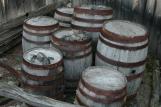15
When smelting operations were not available, the handpicked ore was packed in barrels and shipped to Swansea, Wales. Smelting operations, in Bruce Mines, were built in 1847 by the Montreal Mining Company.16
Different methods of working the mine were used in the early years.The Tut System
The miners were paid according to the quantity of ground cut. This was beneficial in that the "passageways were roomy and followed definite directions." It was detrimental in that the miners were not particularly concerned with the quality of the ore being taken out.
The Tribute System
This was used for a short time in 1852. The miners were paid per ton of ore dressed. This was detrimental in that "it was less safe because the miners followed only the rich veins; shafts and tunnels were honey-combed and narrow." It was financially beneficial for the company, but many miners refused to work under the 'tribute system'. Due to the high price of copper in 1853 and 1854, (up to £140 per ton) the company returned to the 'tut system' in order increase the output of the mine and to retain sufficient numbers of miners.

